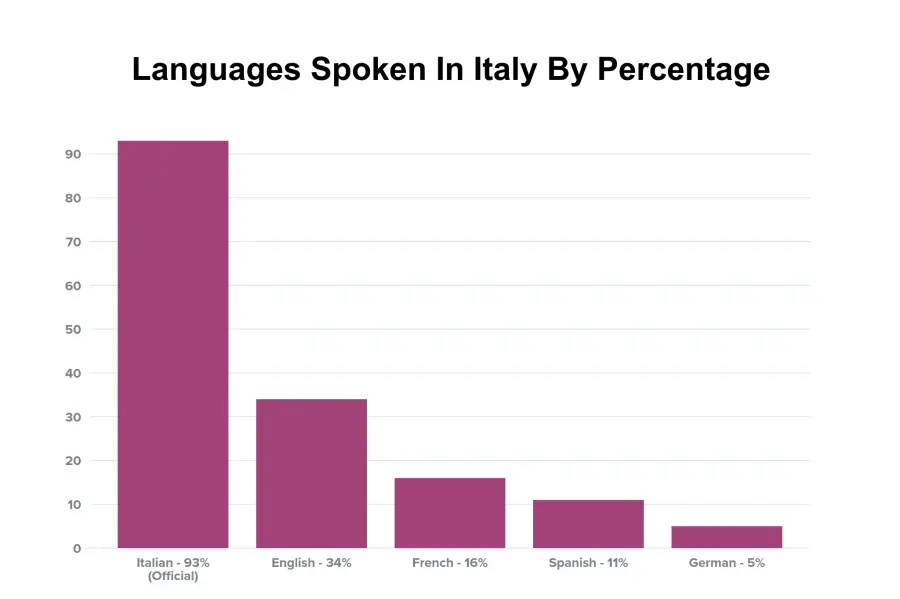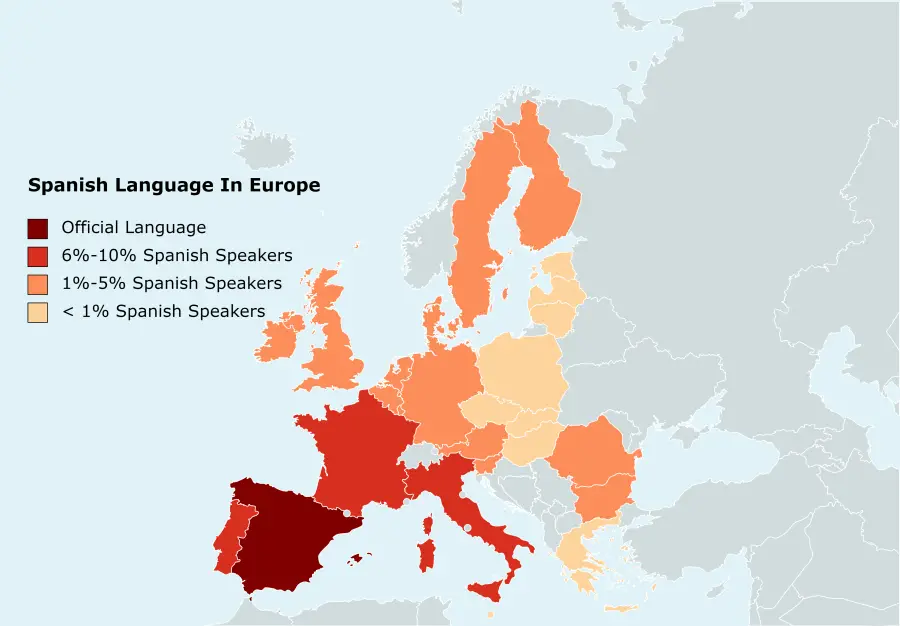With both Spanish and Italian being cousins with ancestry linked through the Latin language, many similarities exist. Yet, when strolling along the Tiber in Rome or through vineyards of Tuscany, is Spanish commonly heard or practically understood by Italians? How commonly spoken is Spanish in Italy?
Spoken Spanish is not common in Italy and is only utilized by 11% of the population. This amounts to 6,650,801 of the 60,461,826 people in Italy. By these numbers you are likely to find spoken Spanish on some level by 1 in 10 people you randomly meet on the street.
I will dive into many major issues around spoken Spanish in Italy in the sections below. We will look at the statistics of how many people speak Spanish in Italy, the likelihood of being able to get around the country only using Spanish and a bit about the languages other than Italian spoken by natives.

Contents
Is Spanish Widely Spoken In Italy?
There seems to be a misconception about the languages of Spanish and Italian. Some think that since a small amount of understanding can be shared between speakers of the two languages that natives in Italy and Spain would naturally bridge the gap and learn one another’s languages. Yet, it this true? How widely spoken is Spanish in Italy?
Spanish is not widely spoken in Italy either natively or as a second language. With only a small percentage of the population speaking it, and no real emphasis placed on it by education, industry, or culture, Spanish is not seen as necessary or advantageous for work or education.
This is not to say that in tourist areas or university settings it is completely absent. There can be those studying it or traveling from Spanish speaking countries that will give it some representation. There could also be an employee here or there in restaurants or hotels that can converse somewhat in Spanish.
With that said, when compared to a language like English, it is relatively unknown and rarely used. Spanish isn’t a language that Italians find useful
Do They Even Speak Spanish in Italy?
There is a number of Spanish nationals that live and work in Italy. As well, there are a small number of Italians that have learned Spanish as a second language. With the number or second language learners being very small, could Spanish be seen as having much of a presence in Italy simply due to Spanish nationals in the country?
For the most part, Spanish is not spoken by natives in Italy on a regular basis. Only the small percentage of Spanish nationals living in Italy will speak Spanish. This usually happens only to family and friends as well, since Spanish doesn’t have a presence in work or school environments.
There is some understanding between Spanish and Italian speakers that I will get into later, but putting that aside, the actual spoken language of Spanish is not that common in Italy in general.
One of the main reasons that many Italians don’t speak other languages than their native Italian in general is due to age. The percentage of the Italian population that is over 65 years old is according to Statista, 23.4%. This has been steadily growing for over a decade.
The older generations of most any country will be more resistant to learning a language. Elderly Italians don’t see a need to learn Spanish due to Italian culture and heritage holding more sway as Italy’s populations age. The older one gets, the less likely they are to want to learn another language for work, education, or pastime.
Do Most People In Italy Speak Spanish At Least A Little?
Let’s look at why most Italians don’t speak Spanish as a second language and the possibility that they can understand Spanish only using their native Italian. I will get more into the similarities of Spanish and Italian later, but here lets look at the numbers of people you may encounter that can understand or speak at least a little Spanish.
The chance of meeting a Spanish speaker in Italy is 1 in 10. This means it will take talking to 10 strangers before one of them will likely have some level of Spanish ability. This also doesn’t mean that they will be fluent. The odds are just 1 in 10 that anyone will know some Spanish in Italy.
These odds will likely go up slightly in tourist or city centers with medium to large populations. Another factor that will raise the chance to find a Spanish speaker is the presence of a university. With international students and those learning languages on campus, it is a stronger bet.
Later I will look at some of the main cities to check if Spanish speakers are your goal. You will find that those at the top of the list will have both lager populations and a sizable university campus.
How Many Speak Spanish In Italy?
Let’s look at the hard numbers. This will give a baseline understanding of how Spanish is used in Italy. Here we can see how many people both native and second language learners speak Spanish in country. So, how many people speak Spanish in Italy?
The population of Italy is 60,461,826 while the speakers of Spanish from slightly conversant to fluent in country number 6,650,801. Some of these are native speakers of Spanish, but many of them are language learners of all different age groups with many levels of proficiency.
Looking just at the number of people speaking Spanish in Italy may seem like a lot, but when compared to those that speak English for example, its relative disuse becomes apparent. English has 20,557,021 speakers which is 13,906,219 more than Spanish.
The thing to keep in mind is that these numbers when put in context mean that 1/10 of the population speaks Spanish, whereas over 1/3 speaks English. With nearly all of them speaking Italian, it is plain to see Spanish has a very minor role.
What Percentage Of Italy Speaks Spanish?
With the totals in raw numbers under our belts, now we should look at how those numbers compare with total populations and other languages spoken by Italians. What is the percentage of people that speak Spanish in Italy?
There are over 60 million people in Italy and roughly 11% of them speak Spanish. The level of Spanish in this percentage of the population also varies wildly. It ranges from the beginner to the fluent with only slight opportunities to practice and advance proficiency.
When comparing this percentage to the 34% that speak English and the 16% that speak French, Spanish comes in at the 4th most spoken language in Italy. Yet, in a country that notoriously holds learning foreign languages in low esteem, this amount and the low proficiency level speaks volumes for the place of Spanish in Italy.
How Many Spanish live in Italy?
With all of this talk of the Spanish language being spoken in Italy, the next logical question is, how many native Spanish people live in Italy? Since they will be the major contributor to the prevalence of the language in Italy, it stands to reason that knowing their numbers will help get a better picture of the language in general.
There are 255,459 native Spanish speakers living in Italy. With only 19,094 of these speakers coming from Spain and the rest from Latin American countries, the European ties between Italy and the Spanish language are noticeably thin. Spaniards visit Italy, but rarely relocate there.
In a study done by Istat (The Italian National Institute Of Statistics), it was reported after looking at the mother tongues of foreign residents in Italy that Spanish was again 4th behind Romanian, Arabic, and Albanian. The native languages of these foreign nationals represent the numbers of people living in Italy that came from other nations.
Here we can see a chart of the Spanish native speakers of Italy as compared with the native speakers of the other top languages.
| Mother Tongue | Population In Italy |
| Romanian | 798,364 |
| Arabic | 476,721 |
| Albanian | 380,361 |
| Spanish | 255,459 |
| Chinese | 159,597 |
What these numbers tell us is that most of those speaking or claiming to speak Spanish in Italy will have learned it themselves as a second language. This doesn’t bode well for the level of Spanish you will find even if you do find a Spanish speaker in Italy.
Though the understanding and communication is helped by the close nature of the two languages, it may still be a struggle.
To see other great articles from DoublespeakDojo.com see these links…
- How Common Is Spoken Spanish In Germany?
- How Common Is Spoken English In Chile?
- How Common Is Spoken Spanish In France? (Revealed)
What Are The Top 5 Languages Spoken In Italy?

With Italian being the official language of Italy along with Italian and Latin in Vatican City, it is no wonder that it is the predominate language for well, Italians. Go figure, right? But what other languages have a presence in Italy besides these two? What art the top languages spoken in Italy today?
The top five spoken languages in Italy by percentage and number are:
- Italian at 93% with 56,229,498 speakers mostly native
- English at 34% with 20,557,021 speakers
- French at 16% with 9,673,892 speakers
- Spanish at 11% with 6,650,801 speakers
- German at 5% with 3,023,091 speakers
With the high numbers of elderly citizens and the national sentiment in Italy as a whole, it is little wonder that Italians don’t seek to be highly multilingual or even bilingual. They don’t see languages as particularly necessary in their daily lives and it takes foreign nationals for there to be a presence of any other language than Italian.
Can Italians Understand Spanish?
As mentioned earlier, many know of the closeness of Italian and Spanish. Though this is true, how close are they really? Are they mutually intelligible or are there some overlaps that cause slight shared meaning? Is it true that Italians can understand Spanish?
Italian speakers can understand slow simplified Spanish in spoken form at levels of 50% to 60% comprehension if accents are neutral. Written forms can be understood at higher percentages due to the lack of time constraints on finding correlations between the languages.
There are many Italians that have had Spanish speaking pen pals that found this to be true. Yet, when trying to converse with a Spanish speaker at normal speeds in everyday conversations, the differences become glaringly obvious.
Though they have may shared components of vocabulary and grammar, they are different languages and are not mutually intelligible. When you add in accents and intonation differences, it worsens the problem.
How Close Is Spanish To Italian?
With both Spanish and Italian sharing a common ancestor in Latin, it is no wonder the connections can be readily seen. It should be noted that each of these languages have developed in completely different environments and cultures. With that understood however, how close are Spanish and Italian?
There is an astounding 82% lexical similarity between Spanish and Italian. This means that though the intonation, pronunciation, and spelling may be slightly different, the two languages share a remarkable amount of vocabulary and etymological roots.
To see how close these two languages are on paper makes one wonder why they aren’t more mutually intelligible in practice. The answer lies in how they are used and spoken.
Earlier I remarked about how these two languages grew up in different regions with completely different cultures. Though they both trace their lineages back the the lingua franca of Rome (Latin), over the 1600 plus years since the dissolving of the Roman empire into kingdoms and city-states they have taken on different paths.
Language is inextricably linked to the cultures that incubate them from inception. There are hidden meanings in everything from how, where, when, and by whom a word or phrase is used. Then there are the situational elements. All of this creates a totally unique environment for a language to develop.
This is why when Italians and Spanish speaking people try to converse they have such a hard time. Though the two languages have similar roots, the way they developed is based on centuries of history and culture.
Is Italian More Like French Or Spanish?
Talking so much about the connections between Italian and Spanish does bring up questions of Italian’s links to other languages as well. Take French for instance. It too is a Latin based language. So, the next logical question would be, “Is Italian more like French or Spanish?”
Italian is more like French in lexical similarities, though in practical application the pronunciation and grammar usage tend to make Italian and Spanish more compatible. Italian and French have an astonishing 89% lexical similarity as compared to Spanish and Italian at 82%.
All three are Latin based languages, so this should not come as a great surprise. The differences come in how they are pronounced, the grammar usage, and the cultural meanings attached to idioms. These small ‘sayings’ make up a surprising amount of the everyday language most people use.
Can I Get Around In Italy Only Using Spanish?
Now that we see how much Spanish can be expected in Italy, and how much Italians can or cannot understand it, would someone be able to get around in Italy only using Spanish? Would someone be able to work or go to a show only speaking and understanding Spanish while in Italy?
It is extremely unlikely that a visitor to Italy can get by using only Spanish. Everything from normal conversations to signs and media will all be in Italian. Though some slight correlation may exist between the two languages, it will take some form of help if all that is spoken is Spanish.
For those determined to use their Spanish in Italy it can be theoretically done, but it will be slow going. Not only that, but you may run the risk of insulting Italians in non-tourist areas if Spanish is interjected in every situation.
Is There Spanish On Italian Street Signs?
Driving in another country is a daunting task to say the least. Some countries drive on opposite sides of the road from one another, and there are countries like India that are said to be rather ‘lawless’ when it comes to conversing their streets. Since we are discussing Spanish in Italy: Is there Spanish on street signs in Italy?
There is very little Spanish on any road sign in Italy. The majority of the road and caution signs have pictographs like with most of the developed countries of the world. The signs with street names, advisements, or information will most of the time only be in Italian.
For the most part, Spanish speakers will not have a problem with street signs since the pictures displayed are fairly universal and simple to understand.
On the other hand, if you are looking at signs with several lines of Italian text, it may take a bit to decipher it. It is not impossible to do and with Spanish as a background, it is fairly easy to find connections.
Is There Spanish In the Italian Workplace?
Most all that make the move from their home countries to a foreign soil do so with one of two goals in mind. Some do it for education, but most do it for employment. With hundreds of thousands of non-native peoples living and working in Italy, is there a chance that Spanish could be found in the Italian workplace?
Other than tourist areas there is virtually no Spanish spoken in Italian workplaces. There can be some instances in internationally connected firms with dealings in Spanish speaking countries, but these are very specific and rare circumstances.
The areas most notible for the Spanish language in Italy will be hotels, tourist destinations, and some university campuses. You may find some employees in airports or train stations that have some level of Spanish, but this will also be hit and miss.
Is Spanish In The Italian Media? (Movies And Television)
Some countries choose to leave films and television shows in their native languages and simply add subtitles for viewers in their respective lands. Others adapt a different policy. They employ voice actors and ‘dub’ movies (silencing the original spoken language and inserting voice acted native ones) and television.
Which of the two is utilized in Italy? Is Spanish heard from large and small screens in Italy?
Since the rise of the Italian dubbing industry in the 1930s, nearly all movies or television shows in Italy are dubbed into Italian. There may be some exceptions in limited run theaters or for special showings, but by in large there will be no Spanish language on Italian screens large or small.
Other countries like German also hold to this same policy. There can be exceptions, but for the most part, you are going to find dubbed versions of most every show or film no matter the original language.
Where To Find Spanish In Italy
Now that we have a better picture of the impact of Spanish on the Italian populace, let’s look at where you are most likely to find it in country. There are two main sources of foreign languages that hold true in most every country. One is a college or university campus. The other will be large population centers, namely cities.
So, where in Italy can we expect to find spoken Spanish?
- Rome – Population 2,895,206 – Large tourist areas including Vatican City and Sapienza University of Rome
- Milan – Population 1,437,436 – More large tourist areas and University of Milan
- Naples – Population 962,736 – The tourist areas here are popular and University of Naples Federico II
- Turin – Population 870,599 – Tourist areas here are smaller but still famous and University of Turin
- Palmero – Population 658,037 – Tourism is not as big here, but they do have University of Palermo
Of course there are other places that you can find Spanish speaking communities and students learning Spanish. It is just more likely that you will find it in one of these population centers.
Spanish In Italy Compared To The Rest Of Europe

Are these numbers and levels of Spanish in Italy odd? What is it like for Spanish in other countries in Europe? With Spain being a major part of the European landscape, how much influence does its language have over the peoples and cultures of neighboring countries. How does Spanish use in the countries of Europe compare?
Spanish use in most every country in Europe except Spain is relatively small compared to many others. Spanish is rarely used by over 10% of the population with others like English being many times utilized by 1/3 of the people. Spanish doesn’t have the employment or cultural draw.
With Spain being the only country in Europe with Spanish as its main official language it may stand to reason that it is inextricably linked to the cultures of Spain. There are some countries that have small portions of their populations that speak Spanish, but its draw for employment and study abroad don’t compare enough with others.
The Final Word On Spanish In Italy…
Spanish both in spoken or written form is not something common in Italy and it is not hard to understand why. With an aging population in Italy and a low view of learning foreign languages it is not just Spanish, but most languages that Italians shun.
There is also the fact that many Spaniards and those from South and Central American countries don’t tend to move to Italy for work or study. This could change in the future, but for not this seems to be the case.
Here are other articles you will enjoy…
